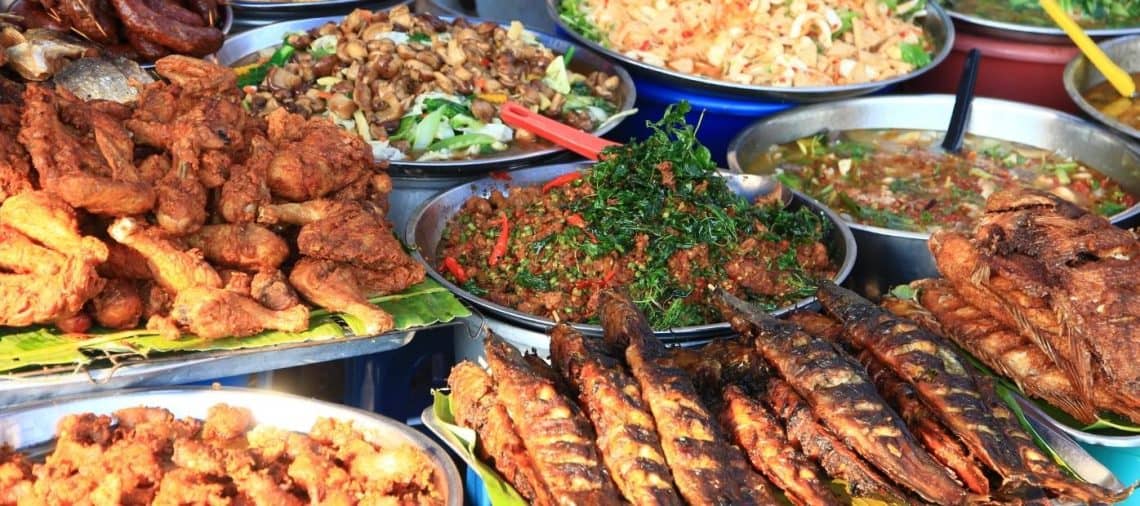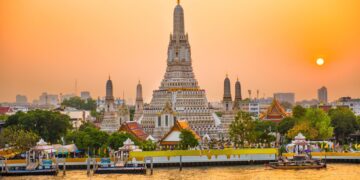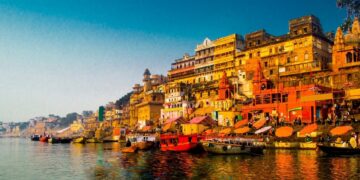If you’ve ever eaten Thai food, chances are you’ve already fallen in love with it. And if you’ve visited Thailand and delved deeper into what Thai food is all about, the love story is probably forever. But if you haven’t yet gotten acquainted with Thai food and are about to go to the Land of Smiles, you’ll find some suggestions on what to eat in Thailand – and, more specifically, what food to eat in Thailand – and some traditional dishes every traveler should try. Because when it comes to gastronomy, this country is a veritable explosion of flavors. In other words, Thai food is magnificent.
- What to eat in Thailand
- What to eat in Thailand for breakfast
- What to eat in Thailand for lunch and dinner
- Tom Yum Goong (spicy shrimp soup)
- Yum Talay (spicy seafood salad)
- Pad Thai (Thai fried noodles)
- Panang (Thai curry)
- Kao Niew Ma Muang (mango sticky rice)
- Vegetarian Cuisine in Thailand
- Drinking Water in Thailand
- Coffee in Thailand
- Beer in Thailand
- What not to eat in Thailand
- What to eat in Pattaya
- What to eat in Phuket, Thailand
- Conclusion
- Pin it!
What to eat in Thailand
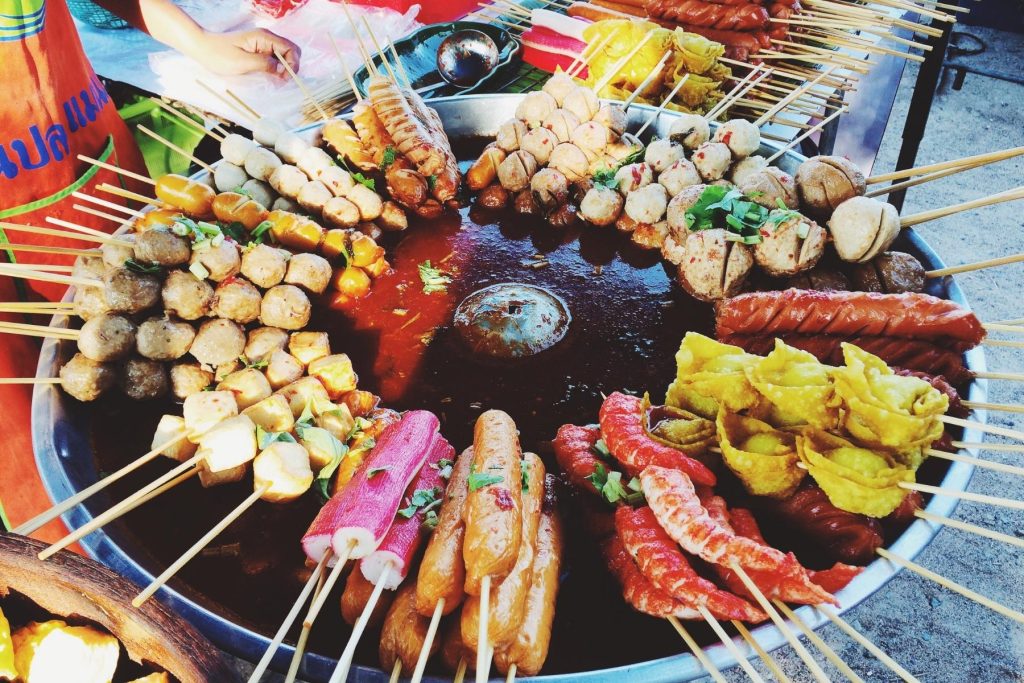
Eating well in Thailand isn’t as tricky as it sounds. It’s true, the menu is varied, and you might be hungry every few hours. But that doesn’t mean you should never sit down.
You can enjoy delicious food without worrying about whether your waistline is expanding. Most dishes are made with high-quality ingredients and prepared with great care. Below are some of our recommendations:
What to eat in Thailand for breakfast
It is not very common to find Western-style breakfasts in Thailand. If you are expecting toasted bread, scrambled eggs, ham, French toast, or a bowl of cereal with milk, you should manage your expectations. Very few restaurants or hotels offer this type of breakfast, except for hotels and foreign restaurants.
Thai food and, generally, Thai dishes can be eaten for breakfast in the same manner as they can be eaten for lunch or dinner, but they will be milder in flavor. In Thai, breakfast is called aahan chow, which means morning food, and it can range from little snacks and porridge to Thai omelettes (Kai Jeow) or even grilled chicken with sticky rice (khao niew).
Among the Thai breakfast foods, you will find a lot of fruits, fresh vegetables, and salads. You’ll also find plenty of coconut milk, rice, and noodles. You can try, without a problem, these traditional Thai breakfast dishes:
Jok
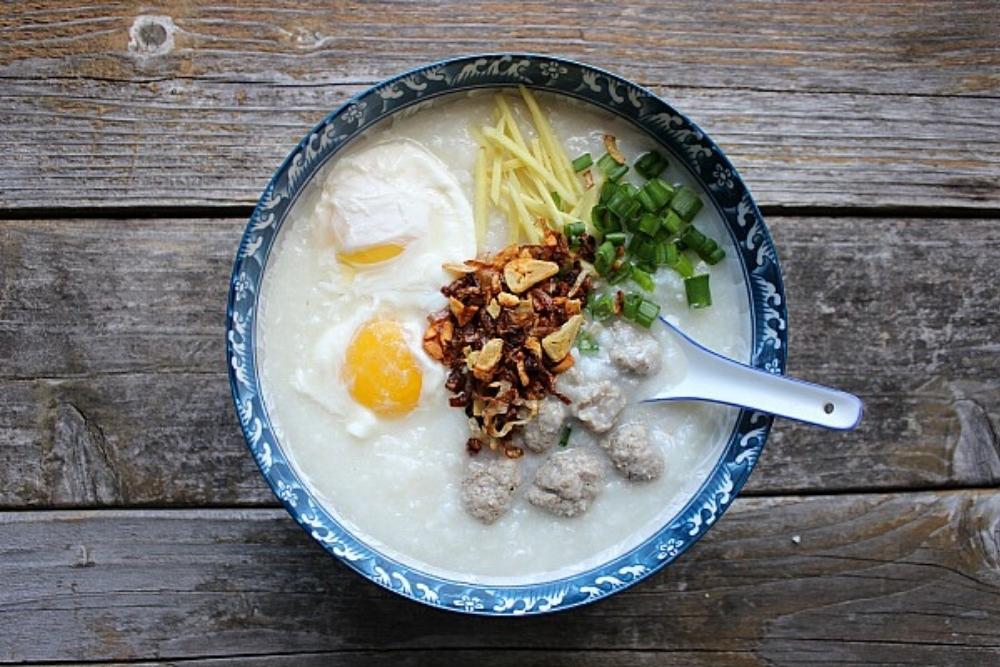
The closest Thai breakfast food to a Western breakfast dish is jok (pronounced “joke”). In contrast to your typical oatmeal, this savory porridge is enhanced with minced pork, green onions, and a poached egg.
Kai Jeow (thai Omelette)
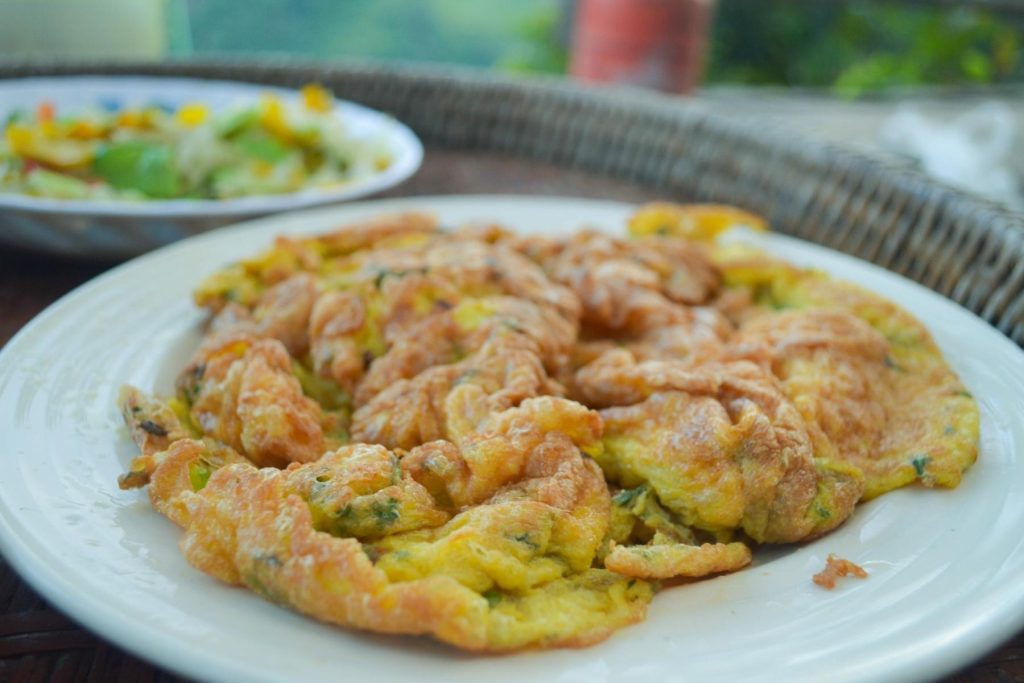
We know that Western omelettes are folded, but Thai omelettes aren’t. In order to make the omelette thick and fluffy, flour or starch is used. The eggs (kai) are beaten with simple ingredients and then fried in a wok until crispy. The omelette is given a deep-fried texture by liberally brushing it with hot oil.
Typically, Thai omelettes are served with jasmine rice. Kai jeow is a popular Thai breakfast food that can be eaten during the day and in the morning, as with all Thai breakfast foods.
Tom luad moo
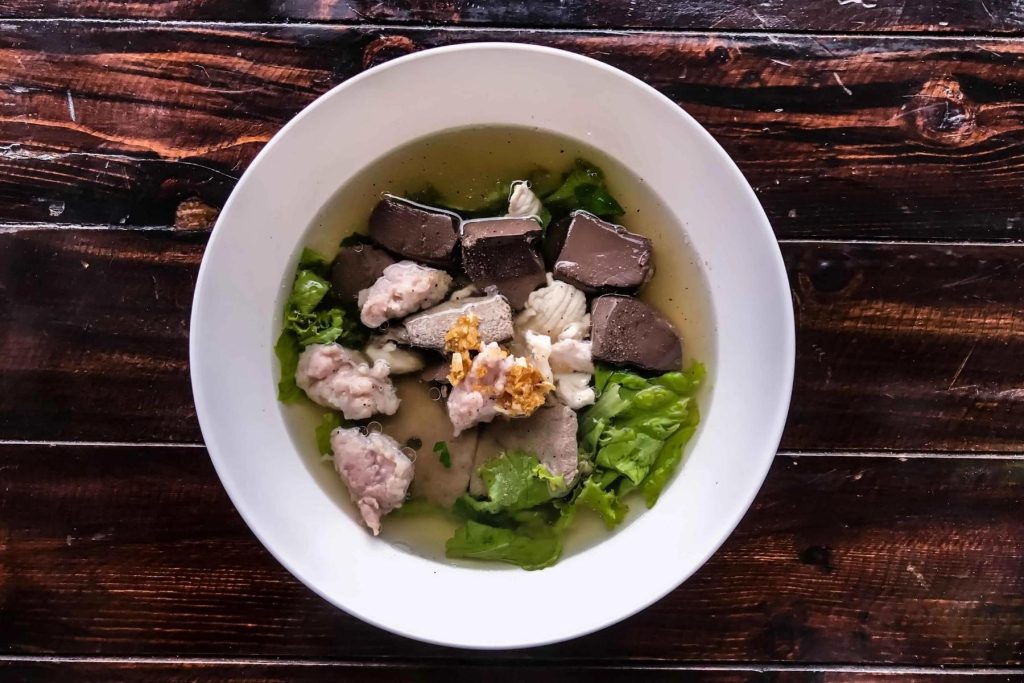
As the name implies, it’s boiled pork blood, which is quite a meat protein option in the morning. The soup usually has intestines, livers, and lungs, along with coagulated pig’s blood chunks that give the soup its name.
Khanom Krok
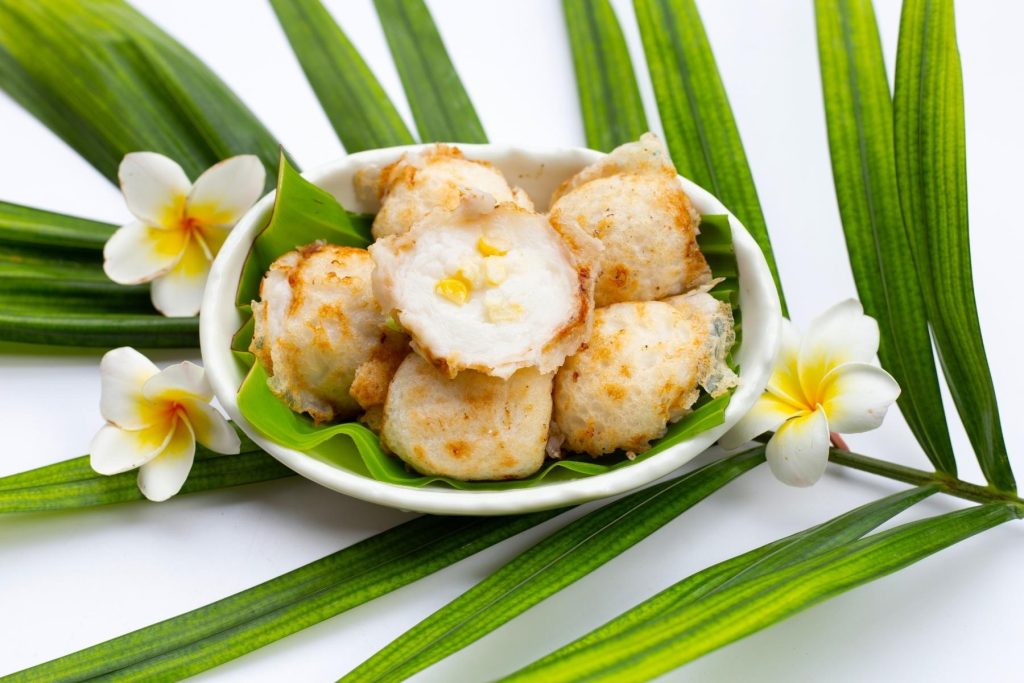
You can’t go wrong with khanom krok if you’re looking for something sweet. Khanom krok is commonly found in street markets, made from rice flour and coconut milk. It is popular as a breakfast or mid-morning snack for a sugar boost to help you get through the day.
Try one of the most unusual combinations for a taste adventure you won’t soon forget – from spring onions to mango and sweet corn; these jelly-like snacks sell fast during the early morning hours.
Pathongko
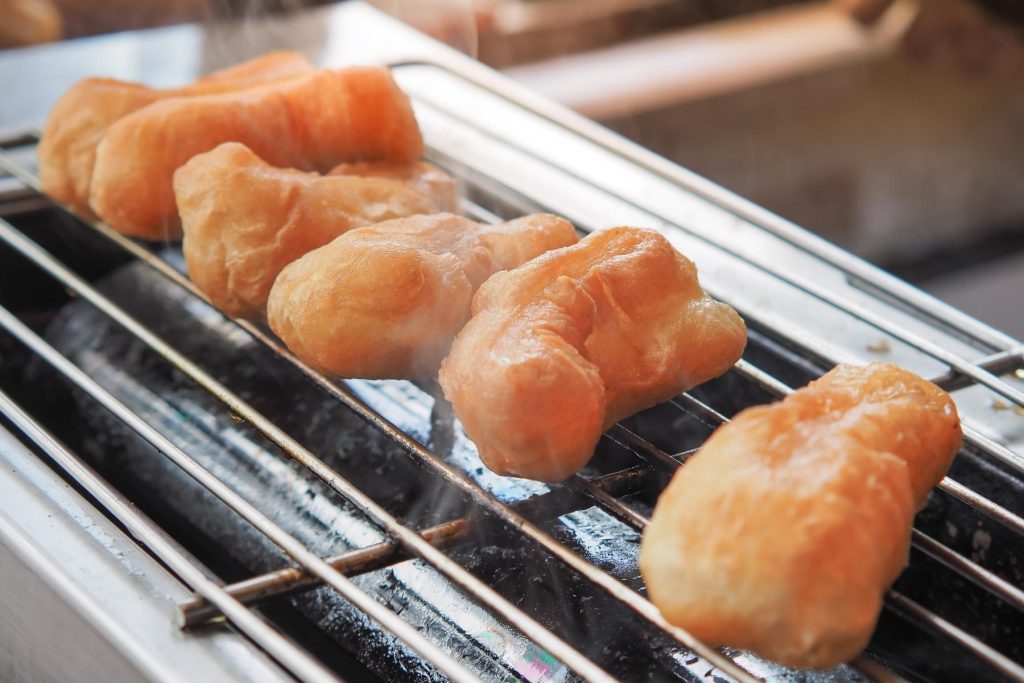
These are deep-fried donuts made with yeast flour. Sugar is a popular topping, but pandan custard and condensed milk can also be found on these donuts. Pathongko might not be the most hearty breakfast choice, but they are certainly delicious. You can enjoy them with a fresh cup of coffee.
What to eat in Thailand for lunch and dinner
Most people eat Thai food at lunch and dinner, so you’ll see lots of fried, stir-fried, and curried dishes. You can also try seafood, meat, and vegetables cooked in sauces like tamarind or spicy peanut.
Thais eat lunch just before or at 12:00, like most people in other countries. A meal is often served with fried rice or noodles or another specific dish. Many foreigners devour two meals at lunchtime due to Thai food’s high-calorie density, which is a problem since portions are relatively small compared to western nations.
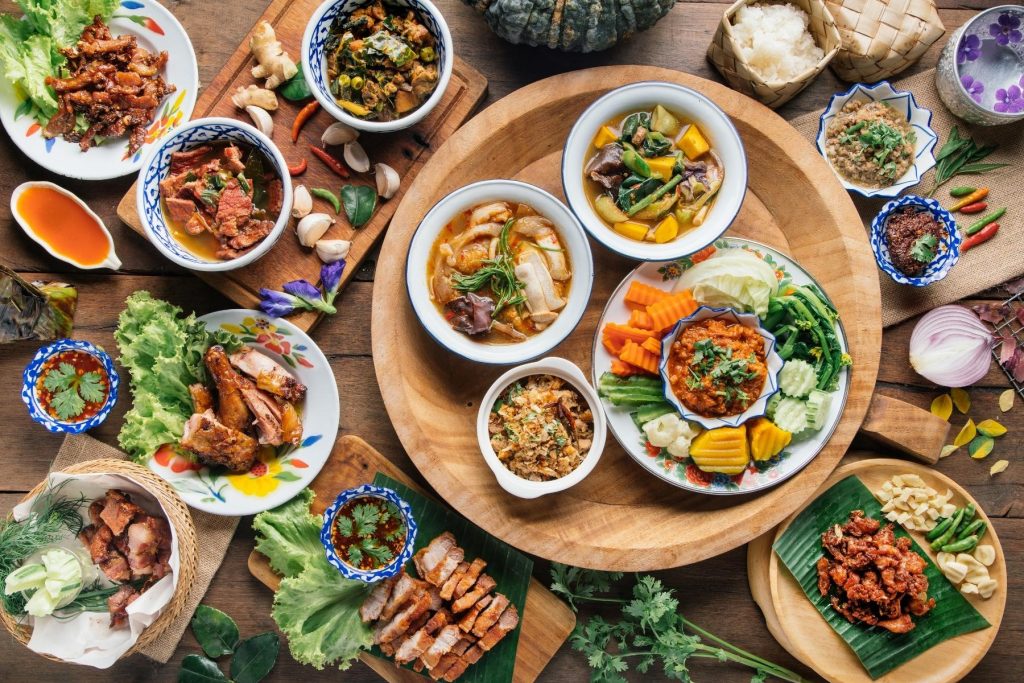
In Thailand, dinner is usually consumed by 18:00 or just after. It is possible, however, that the food will be served later, around 19:30, if you are attending a special event. On most special occasions, everyone at the table shares several different dishes served at a round table. It is common to have fried dishes, steamed dishes, curry or soup, Thai-style salads, and rice.
There is no better way to enjoy Thai food than to share it. Being asked to order your meal in a restaurant surrounded by four people will surprise you. Locals order food in groups, with the eldest diners having the most influence.
Soups are light and breezy, while curries are rich and hearty. Wet dishes can vary according to mood; one dish should be dry as a contrast. Anything served without a bowl, such as stir-fries, is considered dry.
You should try everything at once, although those who are ready should be served first. It is not necessary to follow a course in Thailand. The whole meal includes soup, salad, dips, and a whole fish. The only exception is dessert. In Thai cuisine, rice forms the basis of all dishes, including soups and salads.
Noodles are considered the “sandwiches” of Thai cuisine. Noodle soups and pad thai are considered ideal for lunch and dinner.
Here are some best Thai dishes for lunch and dinner:
Tom Yum Goong (spicy shrimp soup)
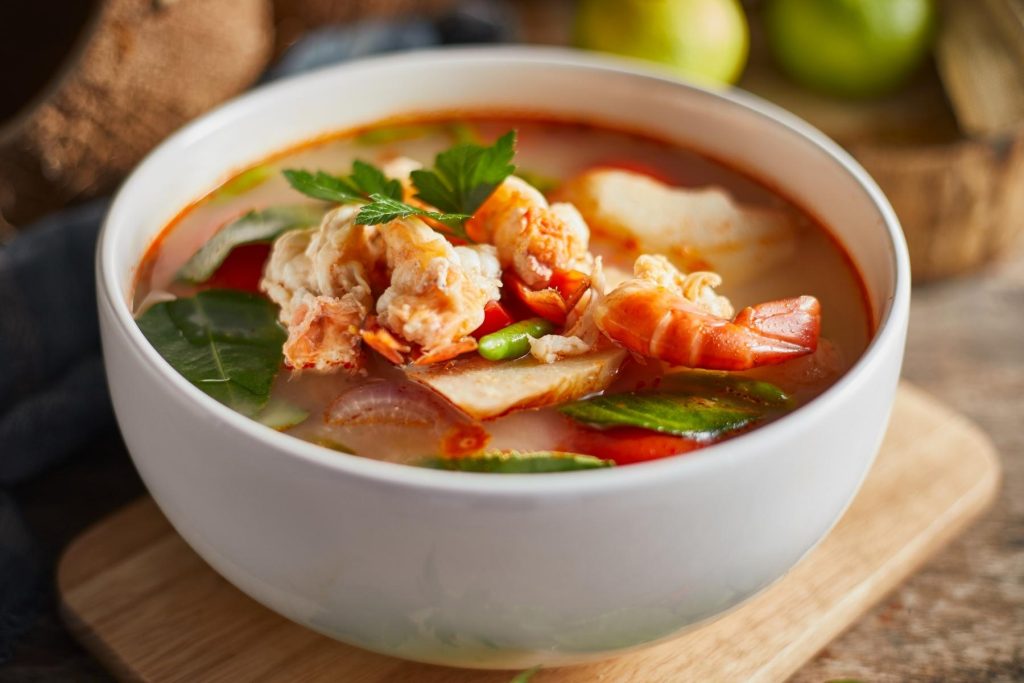
A bold, flavorful, spicy soup. Tom Yum Goong contains Thai ingredients such as lemongrass, chili, galangal, kaffir lime leaves, cabbage, fresh lime juice, and fish sauce. To these are added fresh prawns, mushrooms, and coconut cream (for the creamy version).
Yum Talay (spicy seafood salad)
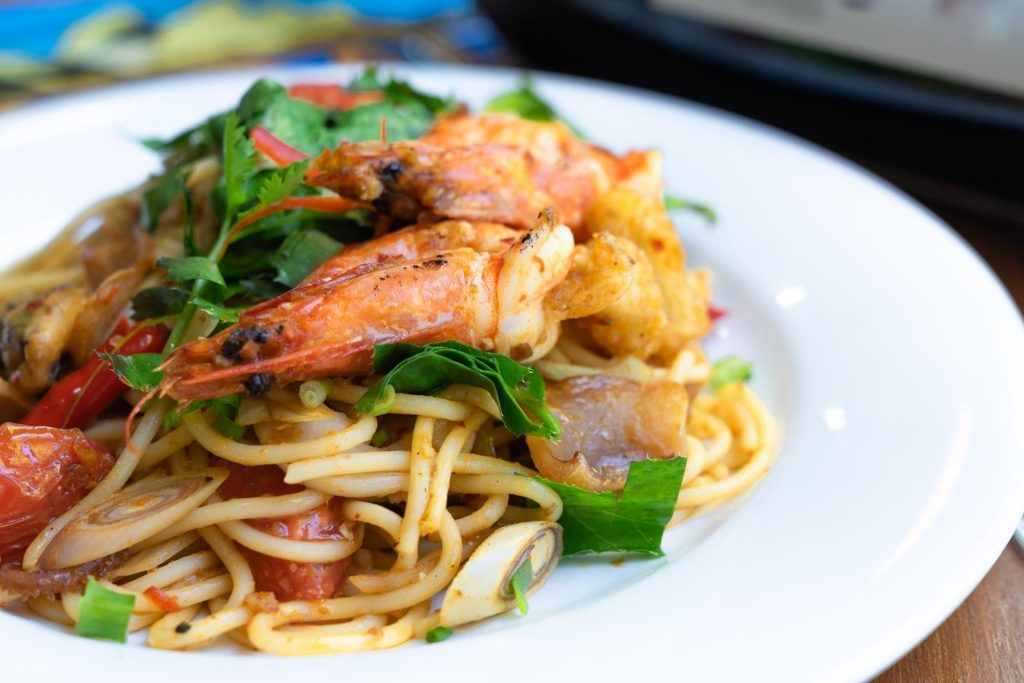
This mixed seafood salad is not only delicious but also healthy. Depending on where you are, Yum Talay can contain any combination of squid, shrimp, mussels, clams, or crab meat. Add tomatoes, onions, and rice noodles.
Pad Thai (Thai fried noodles)
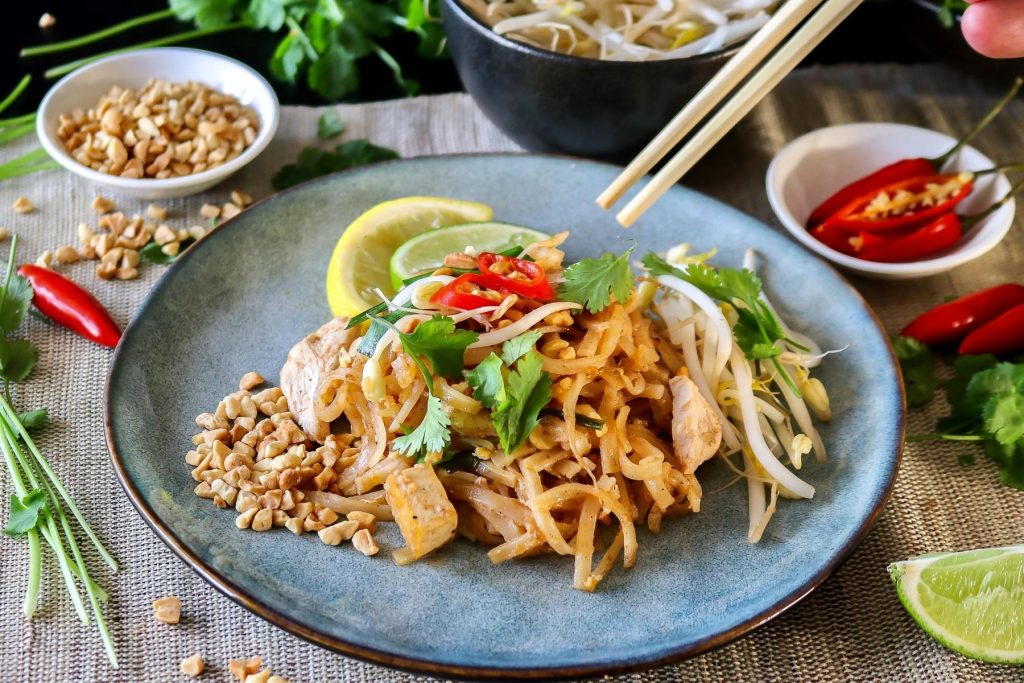
Pad Thai is one of Thailand’s signature dishes and is recommended for tourists new to Thai cuisine. Found on every street corner, it’s cheap and tasty. Pad Thai is a fried noodle dish, which is (usually) made with prawns or chicken, with the vegetarian option also being quite popular.
Panang (Thai curry)
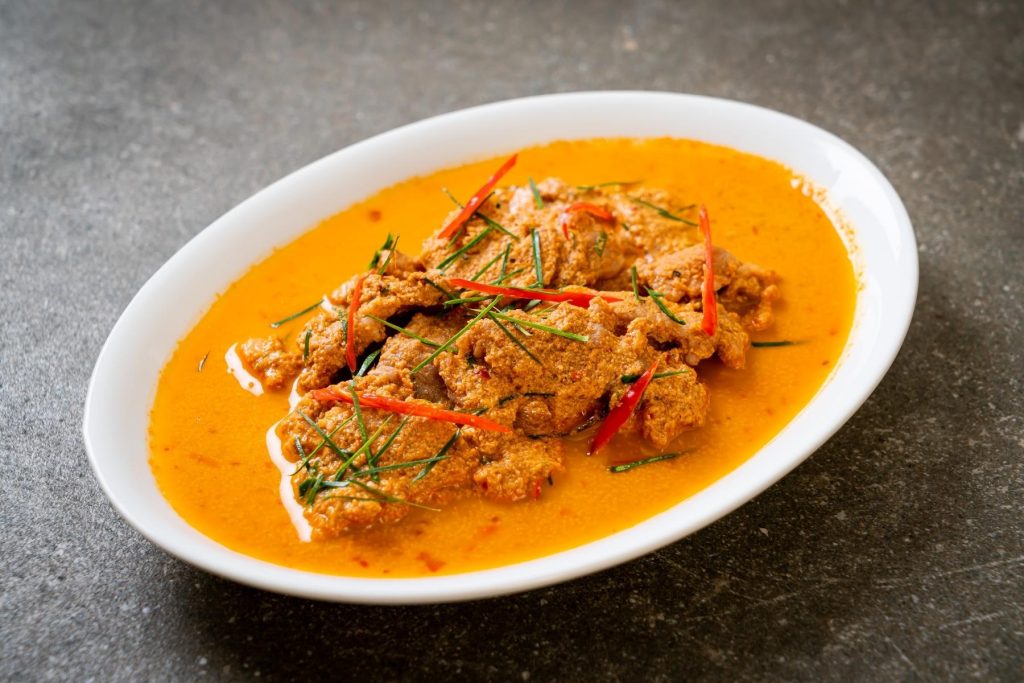
Panang is a milder preparation than Thailand’s other curry counterparts. For this reason, it remains a popular dish for tourists who are more reserved about spicy condiments. Panang curry is served with prawns, although vegetarian options are also popular.
Kao Niew Ma Muang (mango sticky rice)
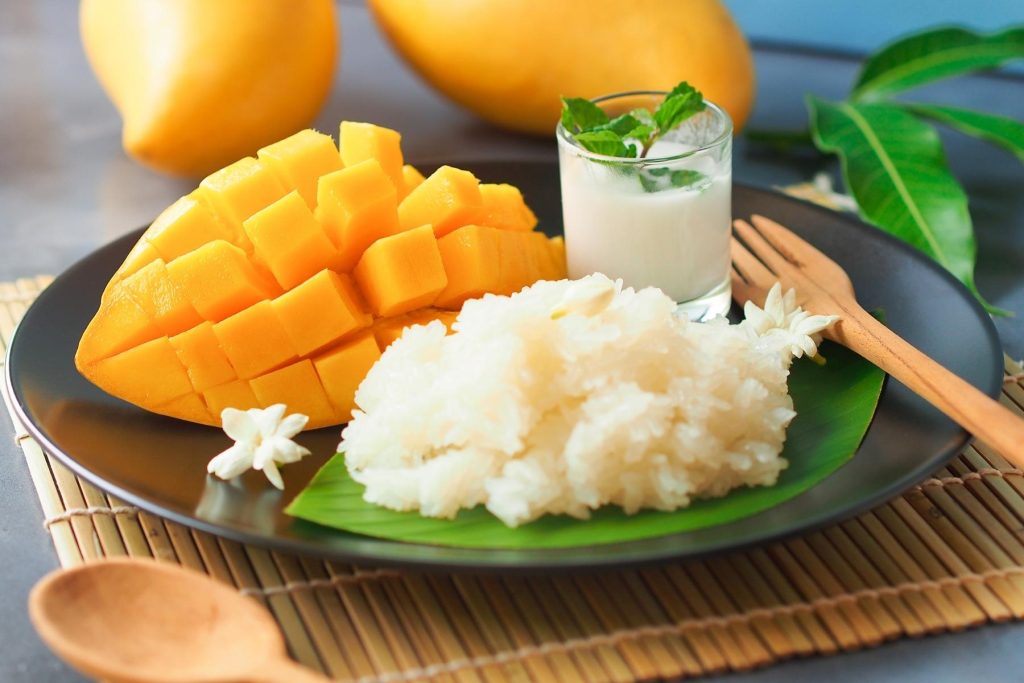
Does dessert tempt you? Try this combination of mango and sticky rice – the most popular Thai dessert. Kao niew ma muang (or Mango Sticky Rice) is a simple but extremely delicious dish, especially thanks to the yellow mango variety. It’s made from sticky rice and fresh mango slices to which sweet milk is added.
Vegetarian Cuisine in Thailand
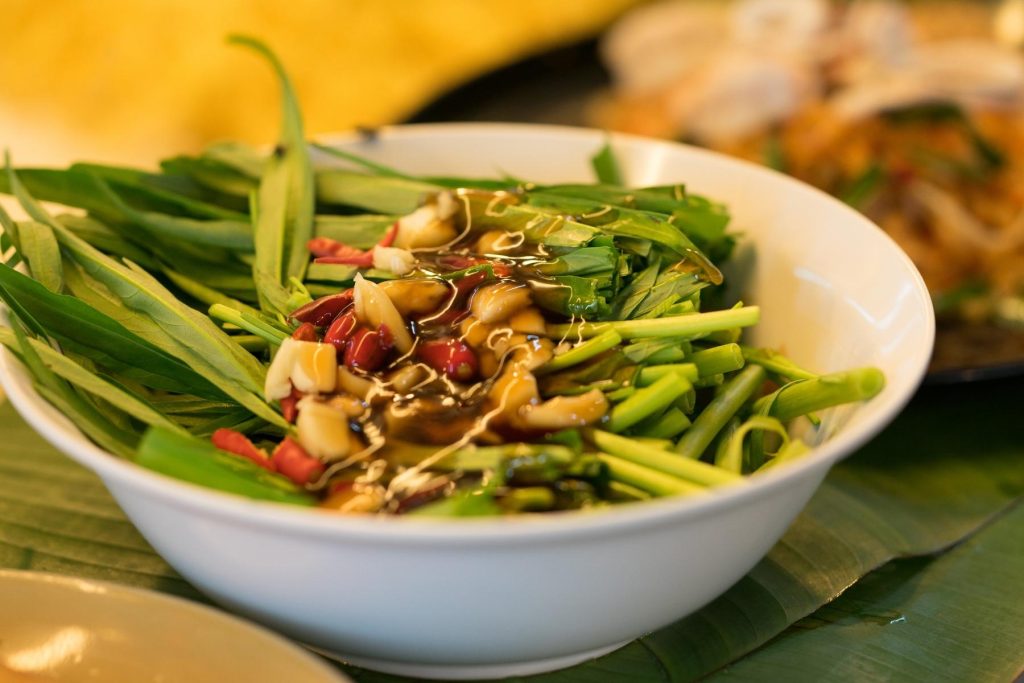
Thailand is a Buddhist country, and Buddhism is strongly connected to vegetarianism. You’ll find a lot of vegan thai food and dishes made with tofu and eggplant. You may also find tofu served with fish sauce.
That’s because, despite Thailand’s reputation as a meat-eater nation, tofu is growing in popularity. Menus often feature it, or you can ask for it to be substituted for meat. You can have a lot of rice with tofu and vegetables, which is easily available.
How to find vegetarian restaurants in Thailand? You will often find a bespoke restaurant nearby if you check before you travel, as many towns are embracing vegetarianism and veganism.
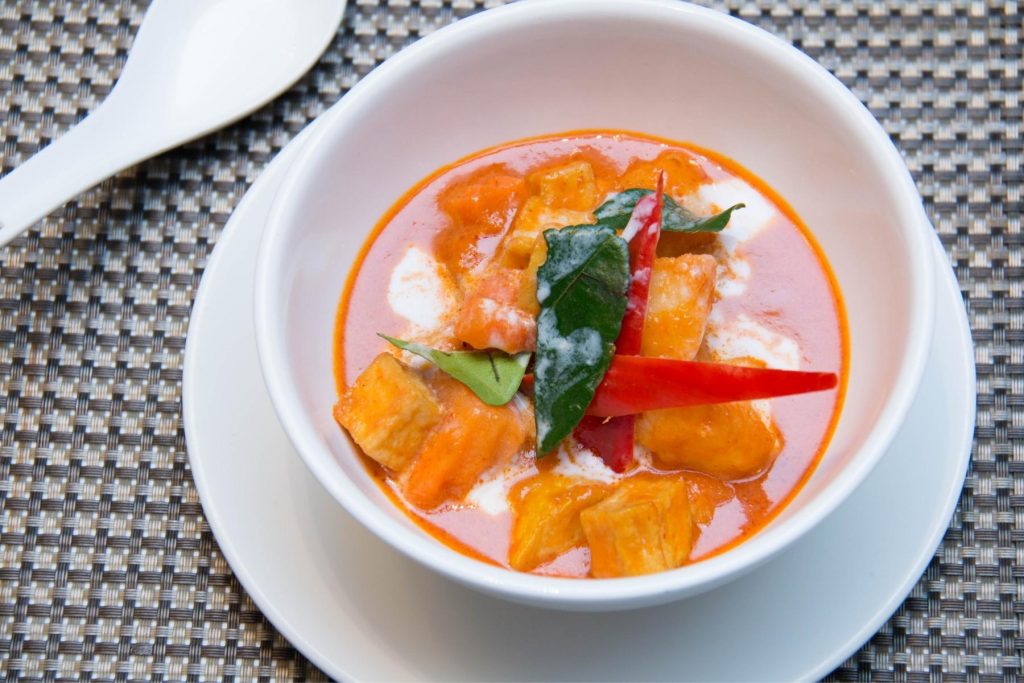
There are often vegetarian sections in most town eateries, which can easily be adapted for vegans, even if they don’t cater exclusively to veggies.
Where else can you find vegetarian or vegan food in Thailand? On sacred sites, in Indian restaurants, and, for the pescatarians, in seafood markets. As a tip, vegetarians must know that most Thai dishes are flavored with non-vegetarian sauces, such as oyster sauce and fish sauce.
Thai vegetarian dishes often contain these two sauces, which are essential ingredients. The dishes can be ordered without these flavor makers, but they’ll taste a little bland.
In conclusion, keep in mind that vegetarian Thai food is very good. Ultimately, it’s about how to eat healthily in Thailand, right?
Drinking Water in Thailand
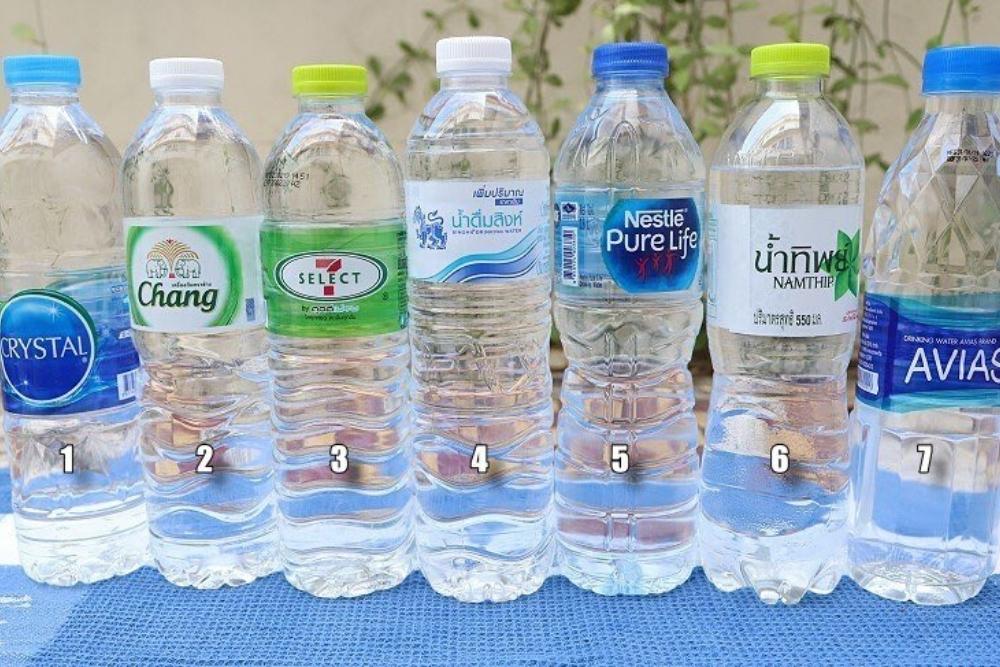
Remember that in Thailand, tap water is not considered safe to drink. You’ll find bottled mineral water everywhere, or you can ask for it in restaurants. Most hotels and guest houses provide complimentary water bottles.
Nestle and Singha are two of the many reputable brands available. Imported water, like Evian, is also available, but the extra expense is not worth it, as the local alternatives are just as good. If you want to be extra cautious, you could also brush your teeth with bottled water.
Furthermore, pay a big attention to the ice. You can be assured that your ice cubes come from a supermarket or 7-Eleven if they have holes in them.
However, ice is often bought in large blocks and hacked into pieces at the bar or restaurant. While the ice itself may be fine, you don’t know what’s been used to cut it or what surfaces it passed through before it made its way into your drink.
Coffee in Thailand
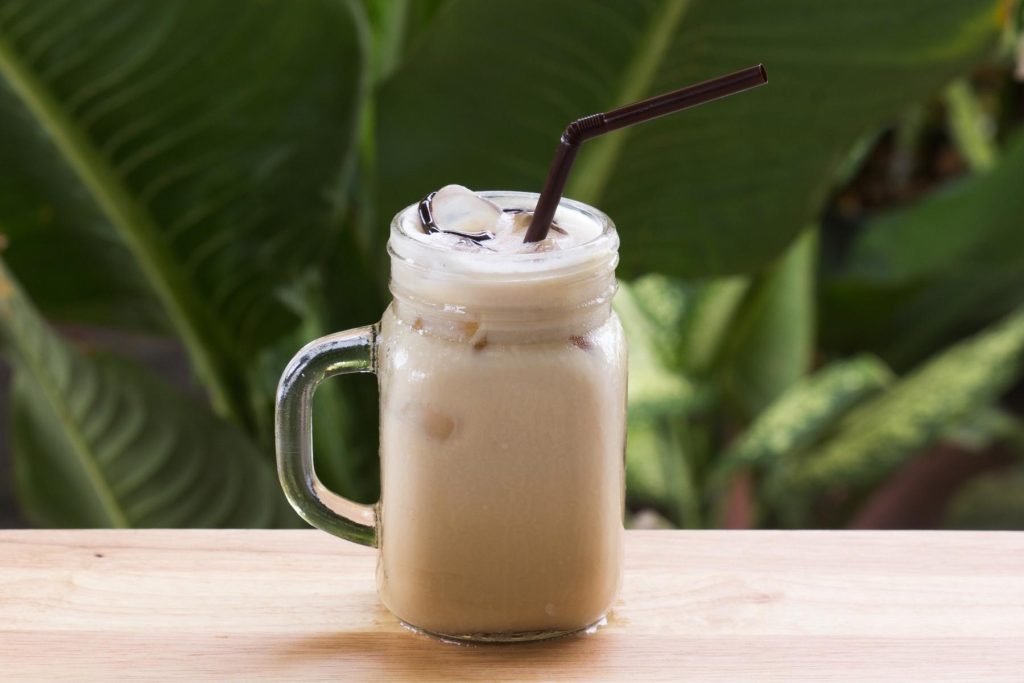
Coffee is ubiquitous in Thailand, and you’ll find it made from robusta beans, which are less bitter than arabica beans. You can order it black or with condensed milk or sugar, but the default is usually no sugar.
Why is Thailand coffee suddenly gaining popularity? Prior to the 1970s, Thailand was not a coffee-producing country in Asia. Now, it is one of the top three.
Chiang Mai in Northern Thailand is largely responsible for the popularity of Thailand coffee. Chiang Mai is famous for Buddhist temples and coffee and produces a large portion of Thailand’s annual export of over half a million 60-kilogram coffee bags.
During the late King Bhumibol Adulyadej’s reign, the Royal Project was launched to eradicate opium cultivation by the hill tribes in the north of Thailand and introduce cash crops. Coffee was one of these cash crops. That can’t explain Thailand’s coffee shops and consumption of coffee.
A cup of coffee costs an average of 70 Baht (1.90 USD, 1.93 EUR – in 2022). Prices range from 30 Baht for a cup of hot coffee at a coffee cart on the sidewalk to more than 30,000 Baht for a kilogram of Black Ivory Coffee, the rarest coffee in the world. You might be surprised to learn that elephants naturally refine coffee in Thailand.
These prices apply to hot drinks only. Iced coffee usually costs approximately 40% more than hot coffee. And you will probably prefer iced coffee to hot coffee when in Thailand.
Beer in Thailand
You’ll find many types of beer in Thailand. It’s made from rice or maize, and you’ll find plenty of Thai brands and many imported ones. Beer is generally served chilled, but you can also find it hot or in a cocktail.
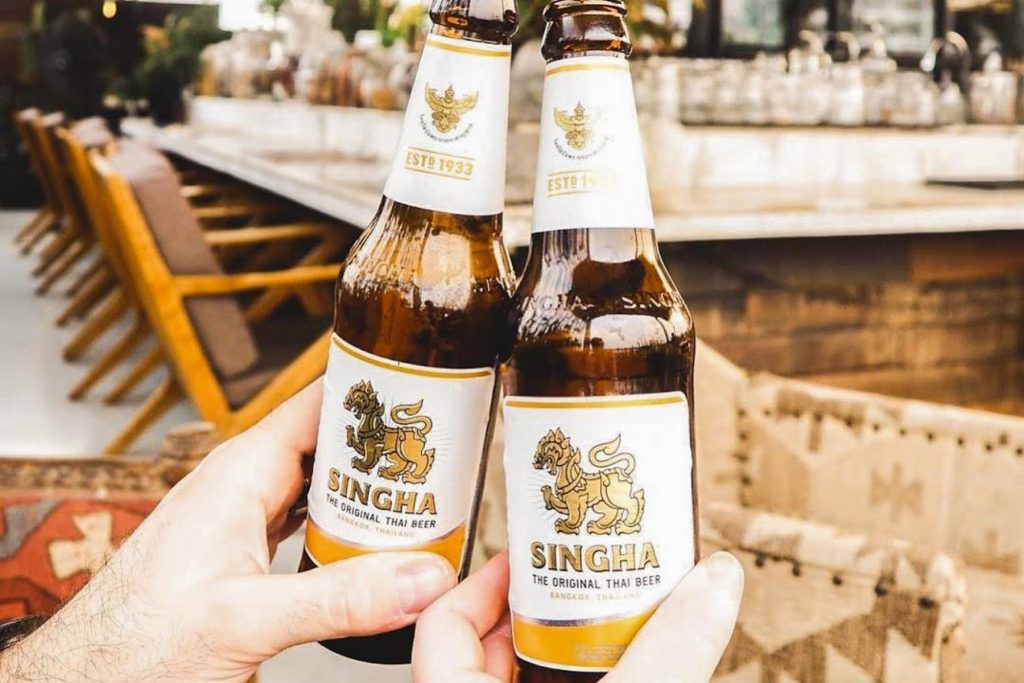
The most popular Thai beer brand is Singha. And not just in Thailand but all over the world. Identifiable by its white label with a golden lion, Singha beer can be found anywhere.
It has been produced, since 1933, in one of the most modern and large breweries in Thailand, Boon Rawd, located north of Bangkok.
It contains 5% alcohol and is made from European hops and 100% premium barley. It’s surprisingly cheap for its standout taste: you can find it for around $ 2 USD a bottle in Thailand.
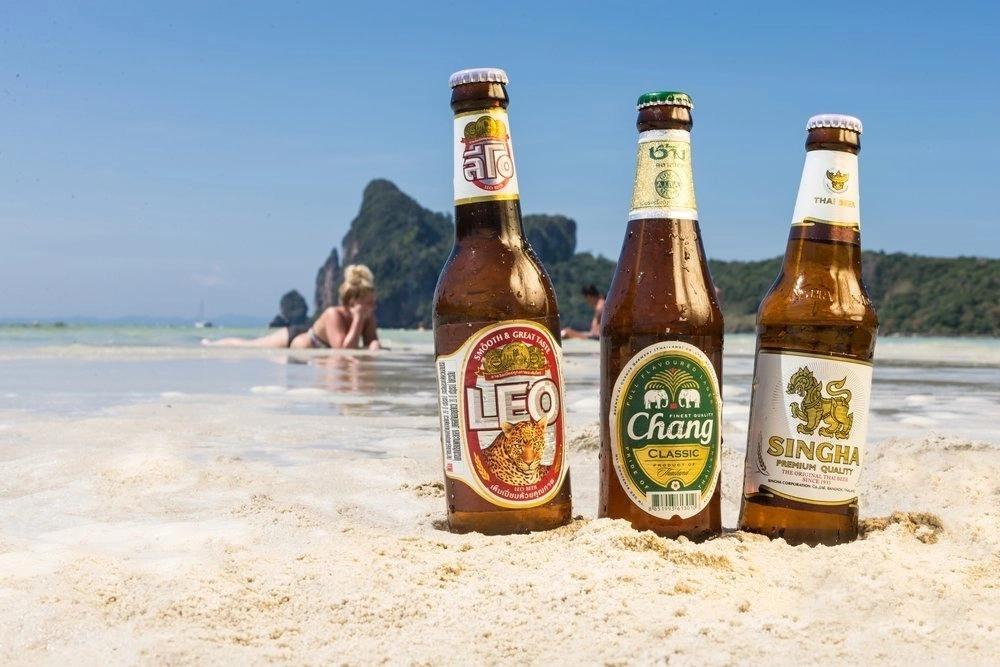
Other excellent beers in Thailand are Chang (also top-rated, 5%), Leo (5,5%), Thai Amarit, Kloster, Phuket Lager, etc.
In Thailand, alcohol cannot be sold or consumed on Buddhist holidays because it is a Buddhist country. Additionally, alcohol is prohibited on election days from 24 hours before to 24 hours after the election.
If you sell beer on religious holidays or election days, you will be fined 10,000 baht and/or imprisoned for half a year.
What not to eat in Thailand
Despite its delicious local cuisines and unique flavors, Thailand has some foods you shouldn’t try because your stomach may suffer. So it is good to know what to eat in Thailand but also what not to eat in Thailand. As we know, eating unusual foods can be extremely dangerous if you have a weak stomach. These must-not-try items include tap water, specific meat, salads, liquor, and insects.
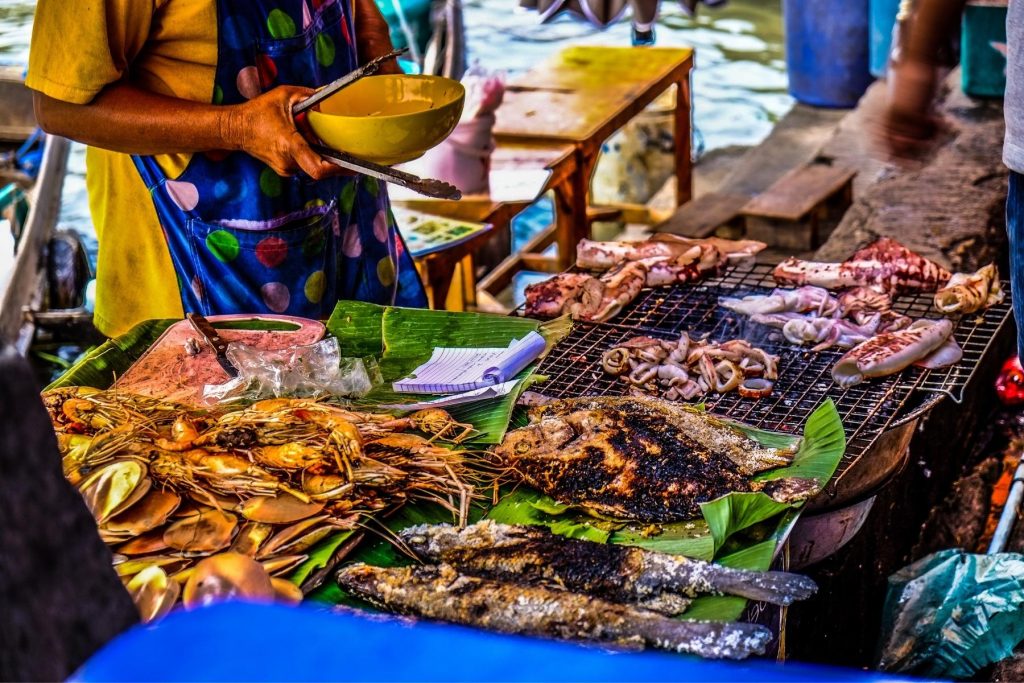
Remember that we have immunity where we live, with all that that means, and it takes about 3-4 months to gain immunity for a place we end up in. Street food in Thailand is generally safe. However, be wary. Never eat raw food. Especially watch the hours when the locals eat, because then you can be sure that the street food is fresh.
Bear in mind that street food stalls do not usually have refrigerators to keep food in. Meat dishes, especially fish and seafood, can be dangerous for a sensitive stomach. So look out for stalls where people crowd to eat, which look as clean as possible and possibly have coolers or even fridges.
On the other hand, a street food vendor makes a living from this, so he can’t afford to make his customers sick, which would hurt his business badly.
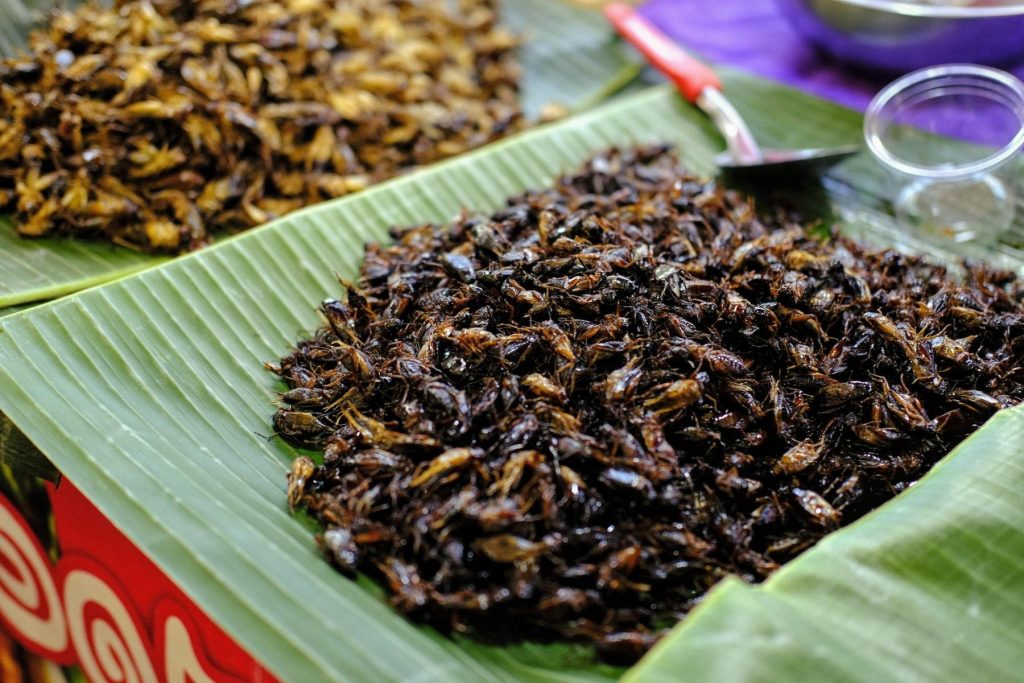
In Thailand, scorpions and crickets are popular street foods. Even though deep-fried insects on sticks look creepy, many people have praised this snack as “delicious”. In Thai markets, you’ll see fried insects, and the bravest will want to try a unique culinary experience.
Despite the fact that deep-fried insects are usually safe to eat, there are some things to keep in mind. When cooking scorpions for deep-frying, ensure the stinger part at the tail has been removed as it contains venom and is dangerous to eat.
Proteins in insects are similar to those in crustaceans, such as shrimp and crabs. It is, therefore, possible to develop allergic reactions after eating insects. This is especially true for those who have shellfish allergies. You should also buy from trustworthy sellers, as some might not clean or properly cook insects, risking your health.
Other strange dishes you encounter in Thailand that you might want to avoid, despite the temptation to try something new, include Shark Fin Soup (for reasons related to the futility of killing sharks to put their fins in food, as they taste neutral), Larb Leuat Neua (a kind of salad made with raw meat and lots of blood), Luu Moo (another raw pork and blood dish), Lao Khao (a very cheap traditional Thai rice liquor made in house or illegal distilleries), Goong Ten (live shrimp salad that can quickly bring you to the brink of diarrhea) and, of course, dog meat (very rarely found in food, only in some remote villages).
What to eat in Pattaya
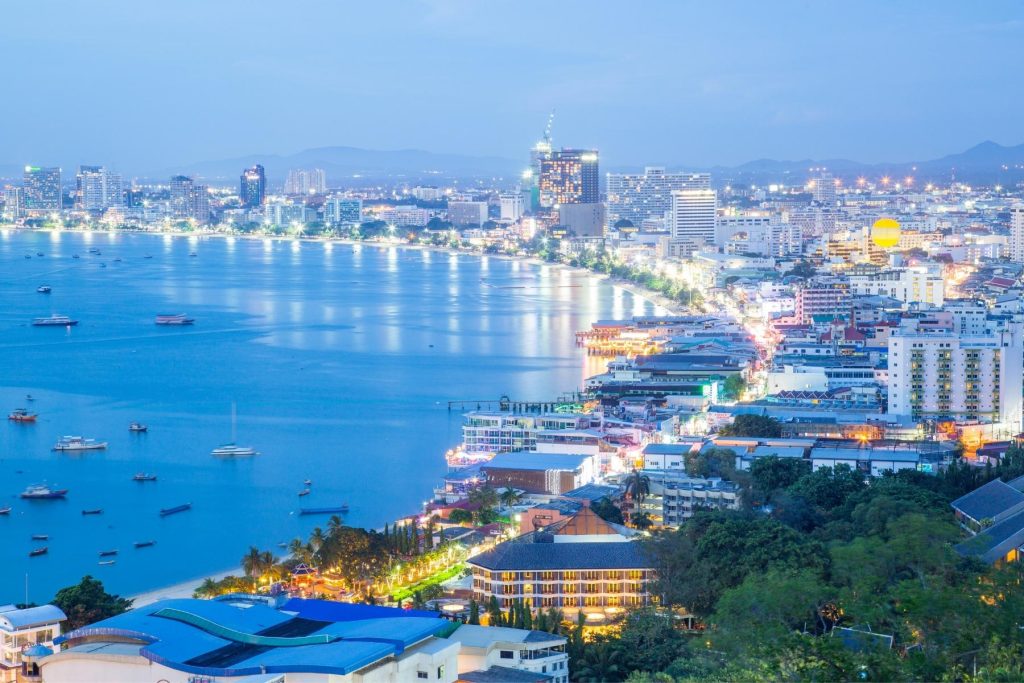
There are many types of cuisines to choose from in Pattaya, and it may be the most important decision of the day to decide where you will dine. Pattaya is located on the east coast of the Gulf of Thailand, 100 kilometers from Bangkok, in the Bang Lamung district of Chonburi province, and is one of the most popular beach destinations in mainland Thailand.
This vibrant, fun-loving coastal town became famous in the early 1980s. Pattaya’s beaches are always bustling with life from sunrise to sunset as water sports enthusiasts and sun worshippers test the crystal clear water.
The cost of breakfast in Pattaya is low. Bacon and eggs, toast, juice, and coffee can be had for between 50 and 80 baht, but this is not a typical Thai breakfast. Of course, a better deal is the hotel buffet, where breakfasts can cost around 110 Baht.
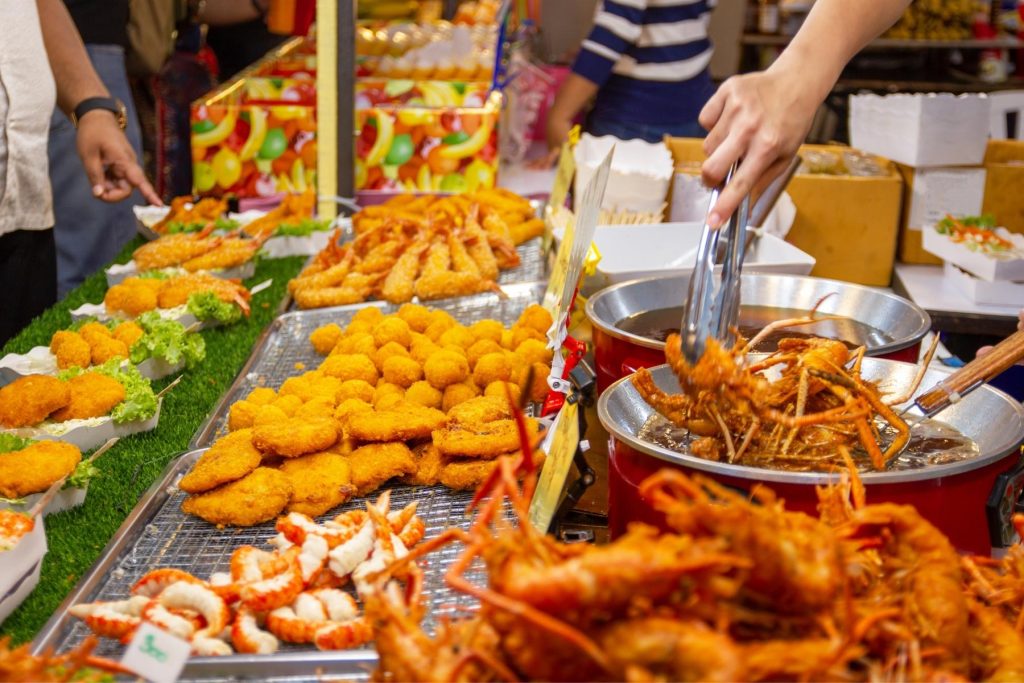
There are many places to eat if you get hungry in the middle of the day. There is a wide variety of food available in Pattaya, from fast food to street food.
Almost everywhere you go, there is someone selling food. One of the best places you can go is the food court at the Royal Garden Shopping Center.
You can then walk around and see what you like among the many vendors. Most Thai food includes soups, rice dishes, and noodles. There are also drinks and desserts available. The majority of meals cost between 30 and 50 Baht.
On Soi Buakhao, just north of Soi LK Metro, you’ll find a group of street vendors or an outside food court. The northernmost is one of the best. You can stop at a street vendor for dinner and buy meat and rice.
Among the dishes he has cooked are boiled chicken, fried pork, and red pork. Each dish comes with rice and costs 25-30 Baht. There is an additional charge of 10 Baht for a bottle of water.
No matter what time it is when you get hungry, you can get food in Pattaya. There are street vendors and motorized stalls selling soups, bar-b-que, rice, and noodle dishes everywhere. You can even sample Northern Thailand snacks such as grasshoppers, silkworms, ants, and beetles.
Still wondering what to eat in Thailand? Eating is a way of life in Thailand, and you’ll find yourself eating four to six times a day. Meals are small in size but huge in taste. Be careful with chili peppers when eating Thai dishes, as some of them may be very spicy.
What to eat in Phuket, Thailand
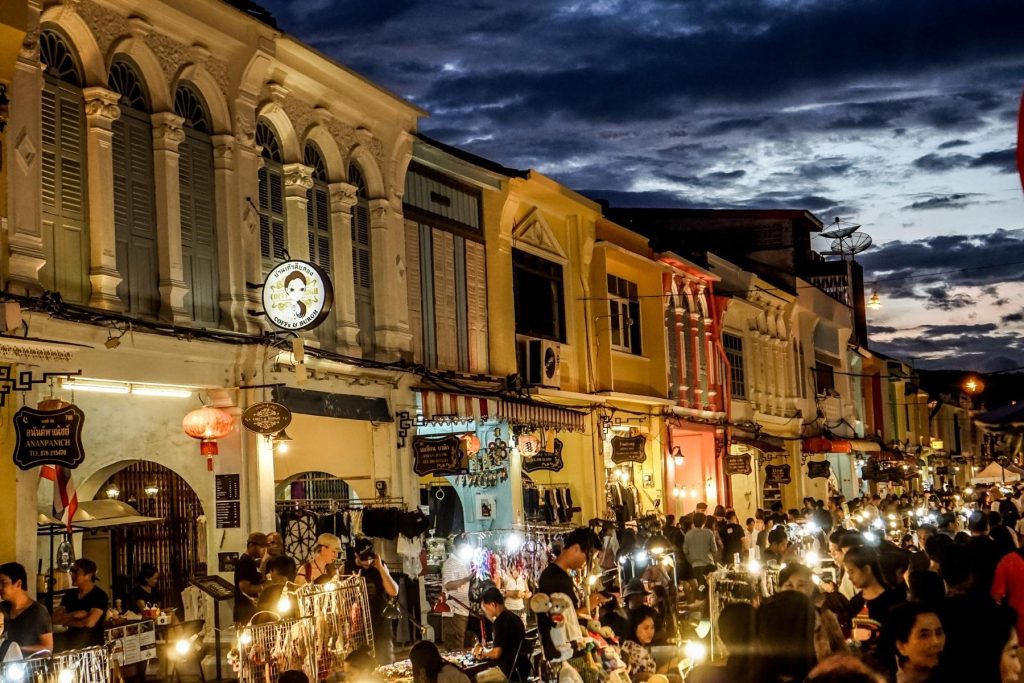
Phuket is the most popular Thailand destination, the largest island in the country. Phuket is known for its white sand, palm trees, clean water, and lively towns. It is suitable for any budget as there are a variety of hotels, restaurants, and tourist attractions.
One of the most nuanced and complex street foods in Thailand is that of Phuket. The island was an important trading post and port where influences from India, China, and the Malay Peninsula entered Thailand long before the rest of the country. The cuisine was transformed into a unique fusion of Asian flavors by bringing in different ingredients and cooking methods.
Diners who want to sample street food in Phuket City must drag themselves away from the sand and cross over to the Old Town. Where else to find street food in Phuket? Although street food is everywhere, you can find some on the beachfront near Graceland resort, nearby convenience stores, and near fresh markets such as Banzaan market behind Jungceylon.
There are no bargaining opportunities here, so don’t try to get a better deal. There might not be a menu, so look around the cart, and if you don’t find anything you like, look at other customers’ tables. You can do tons of variations, but stick to the basics.
For a great Phuket street food experience, try some of these delicious thai dishes:
Roti (Pancakes)
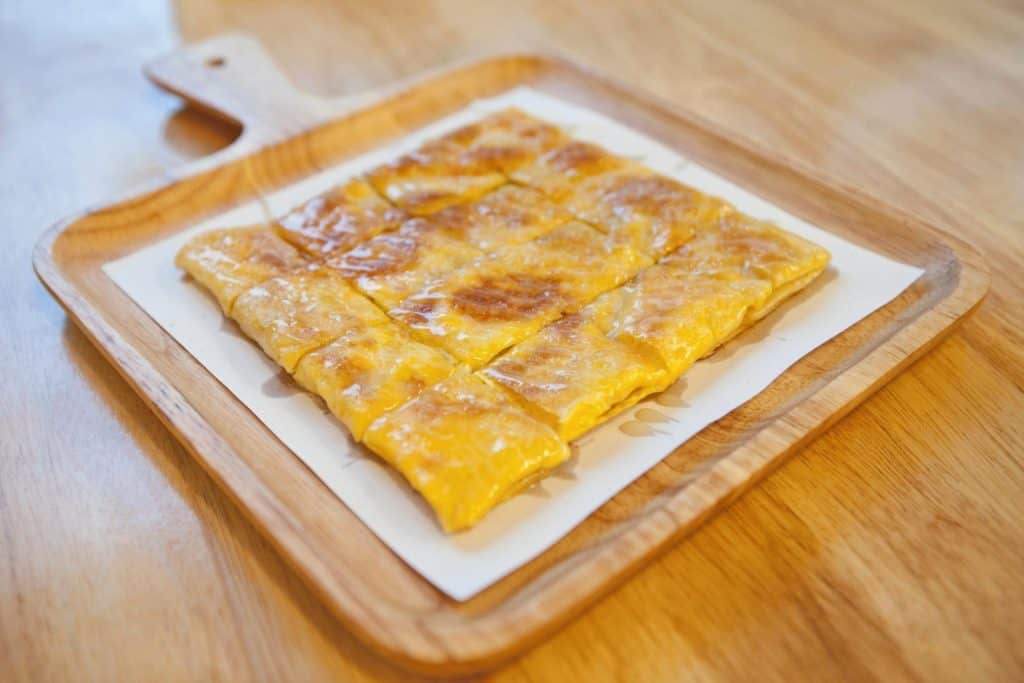
Abdul’s on Thalang Road is a must-visit when in the Old Town. A 70-year-old owner still makes his rotis in the same way as generations before him, with a little help from the rest of the family.
A sweet condensed milk coating covers these crispy shards of wheat bread. The savory version is also available, paired with massaman chicken curry for those without a sweet tooth.
To find Abdul, simply look for the man wearing a fez and slapping dough onto a big hot plate at the front of his shop.
Moo Hong
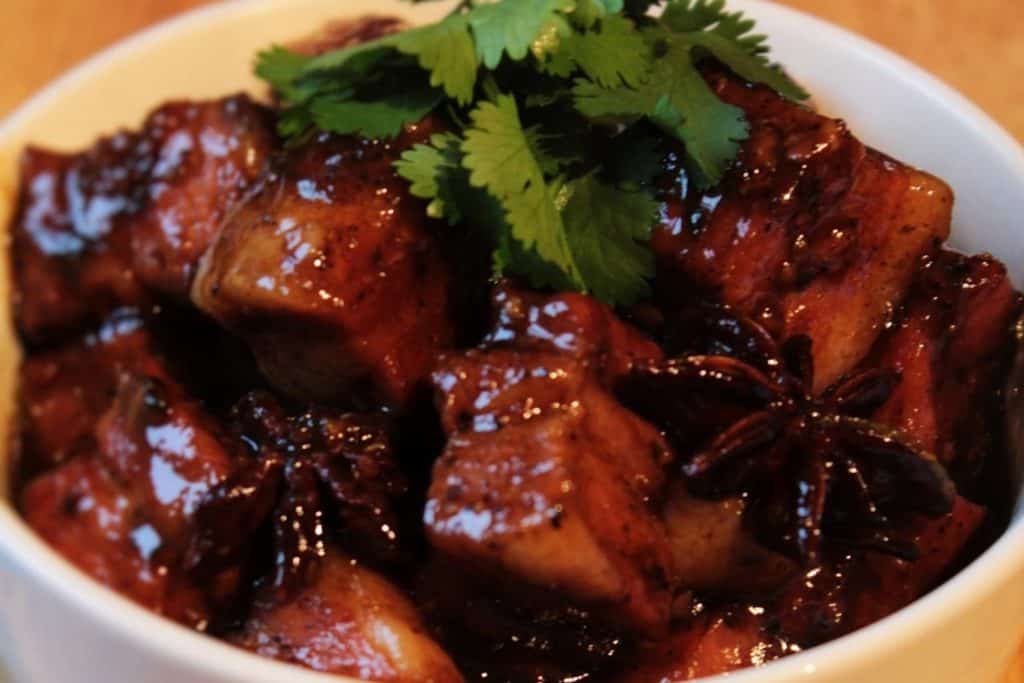
Moo hong is the one recipe that sums up Phuketian cooking. It combines Southern Chinese and island flavors, ingredients, and techniques typical of Phuket’s cuisine. It starts with fatty pork belly cuts braised in crushed coriander root, black peppercorns, star anise, and soy sauce, and then braised in garlic and palm sugar.
Some recipes are dark and savory; others are sticky and sweet.
While the fat and skin are soft and gelatinous, the pork doesn’t lose its structure as it is cooked just long enough to make the meat tender and the fat and skin tender.
Som Tum (Papaya Salad)
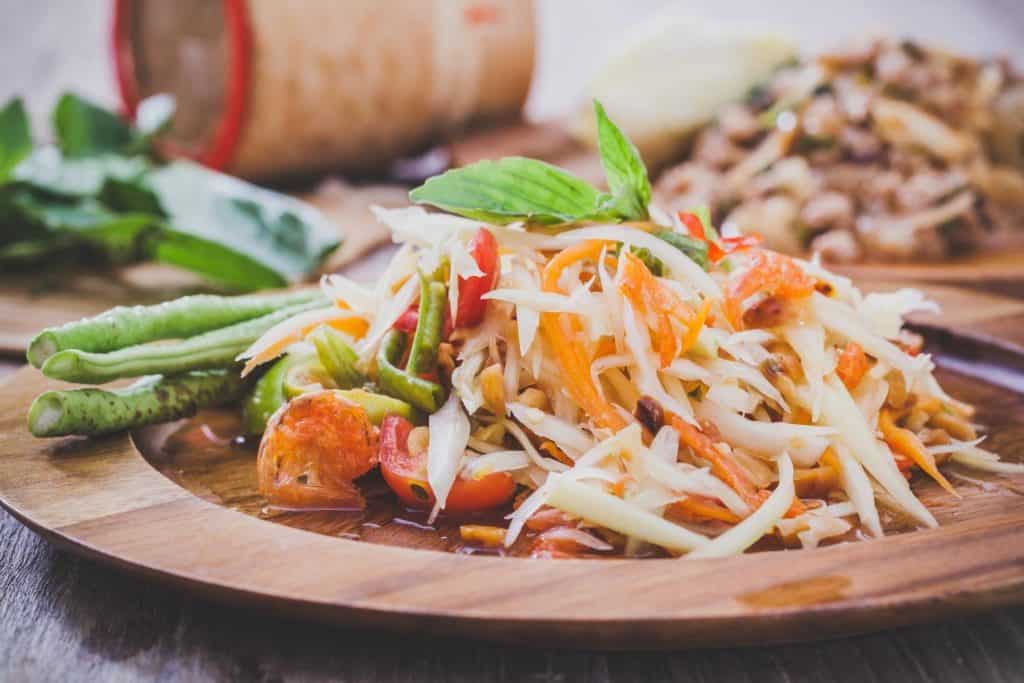
Almost everywhere in Thailand, you can find this timeless dish. Som Tum can be found in several variations, including the super pungent Som Tum Poo Pala (Papaya salad with fermented crab). Thai Som Tum is the safest option, as it usually only contains papaya, tomatoes, lettuce, and green beans.
It is common for the cook to guess how many chilies you can handle if you do not specify how spicy you want your Som Tum to be. You’re a foreigner? It could be one chili or none at all unless you specify! Often, som tum is best served with grilled catfish, chicken, or pork.
Khua kling
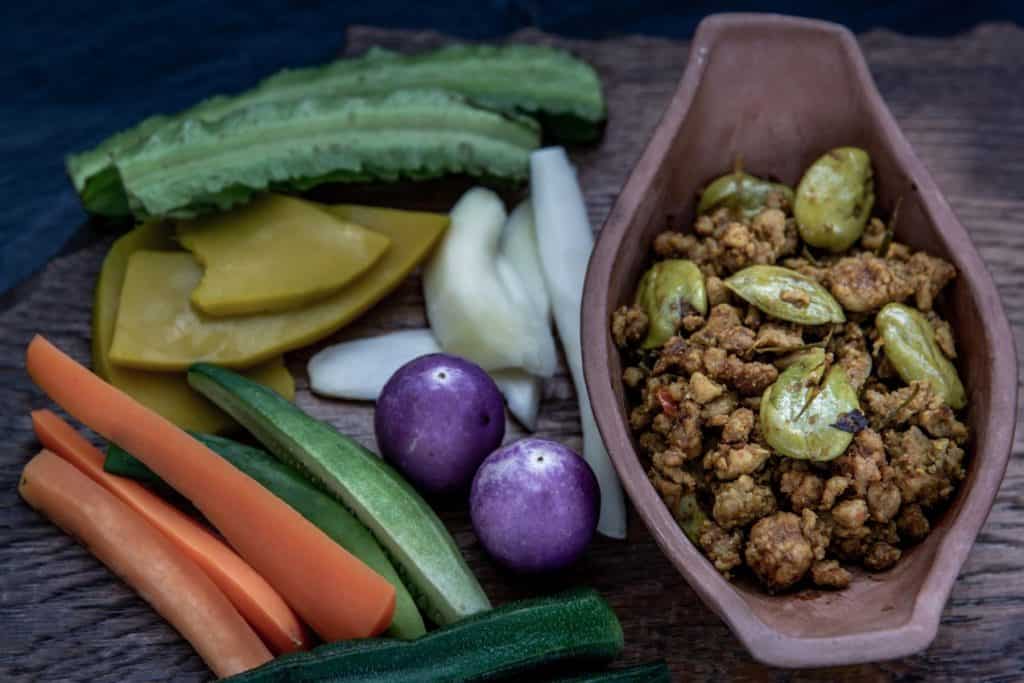
Despite its tongue-singing heat, southern Thai food cannot match khua kling, a dish seasoned with curry paste, lemongrass, galangal, kaffir lime leaves, and a staggering number of Thai chilies, which is dry fried in curry paste, lemongrass, and galangal.
Thai food doesn’t have to be spicy to be good, but khua kling is only good with scorching chili heat. Something isn’t right if your face isn’t numb and your cheeks aren’t sweating. Eat a heaping bowl of steaming jasmine rice and raw cabbage wedges to take the edge off.
Loba
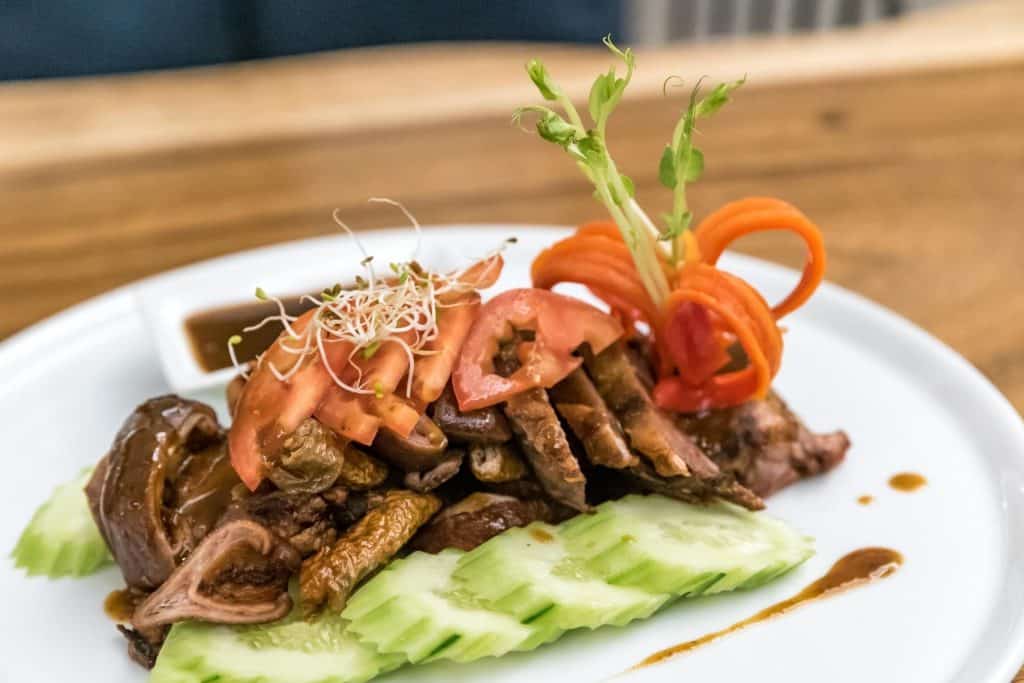
Unless you know how to swim, loba is equivalent to diving into the deep end of a resort’s pool without knowing what you’re doing. Phuket offers a beloved street food for those willing to venture out: tumbling piles of pork offal slow braised and lightly fried in five Chinese spices.
Authentic South East Asian dishes aren’t just about flavor, they’re also about texture, and these chewy but crisp morsels dipped in tangy tamarind sauce are a great example.
Gaeng Som (Sour curry)
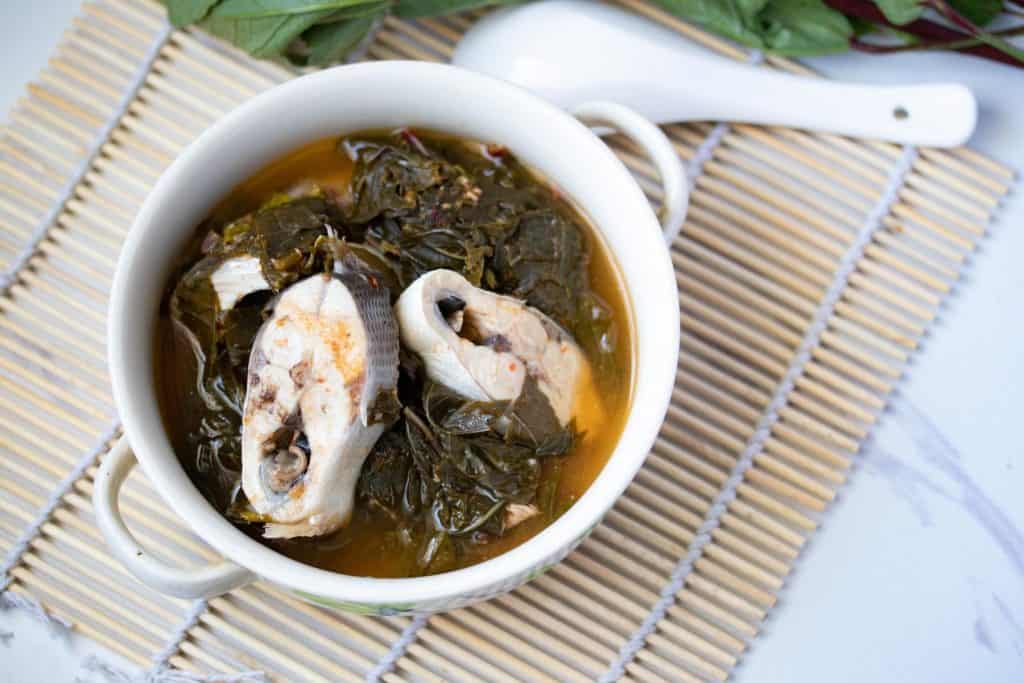
This thin, watery curry is made of fresh turmeric, garlic, shallots, green papaya, and shrimp paste, combined with lime juice for a sour note and fiery red Thai chilies for heat. Some people use pickled bamboo or sticky tamarind as souring agents. Thai curries can be made with almost any firm white fish, but sea bass is the most common, and no coconut milk is used, unlike many other curries. This is the delicious gaeng som.
Conclusion
Now that you have an idea about Thai cuisine and Thai food, all you have to do is get on a plane and fly to Bangkok, Chiang Mai, or any island in Thailand and taste the delicious dishes of the people of the Land of Smiles. What to eat in Thailand? After all, it’s a question only you can answer once you’ve arrived in a Thai restaurant or tried Thai street food for the best Thai dishes of your life.
Pin it!
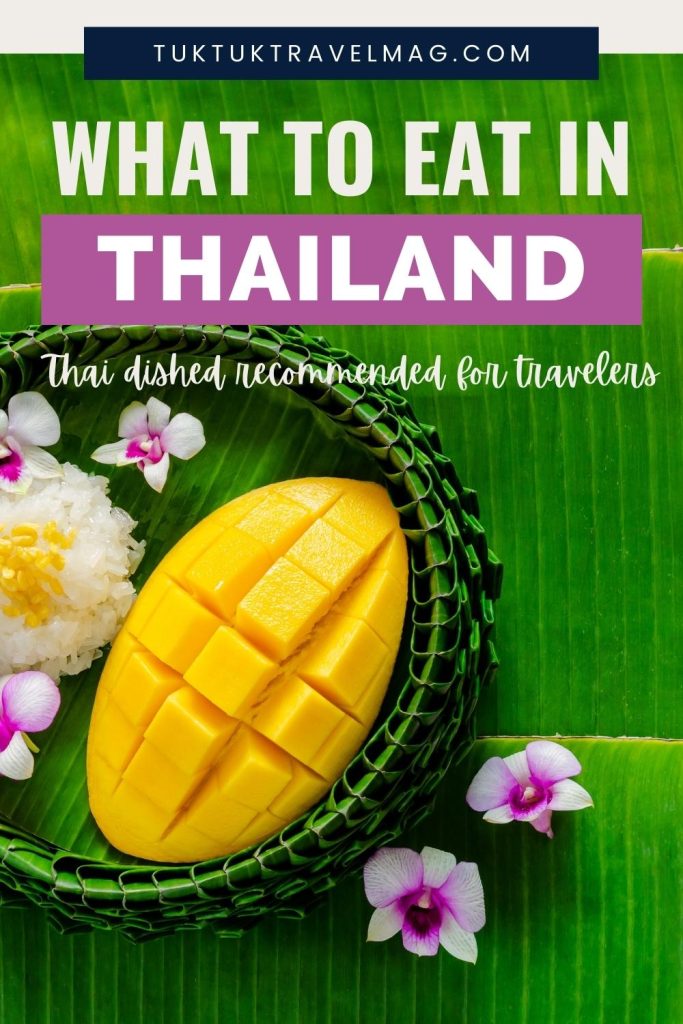
You may also like: One night in Bangkok, eating on Yaowarat Street

